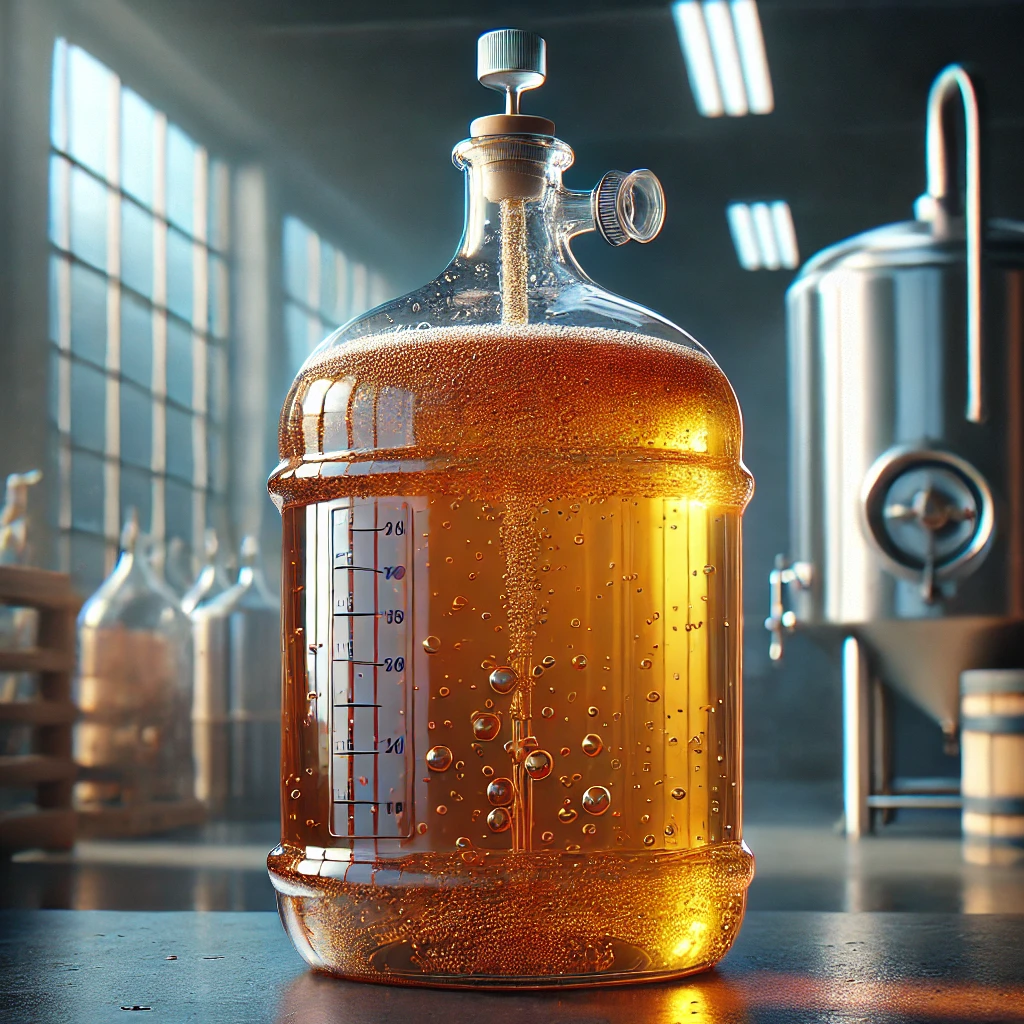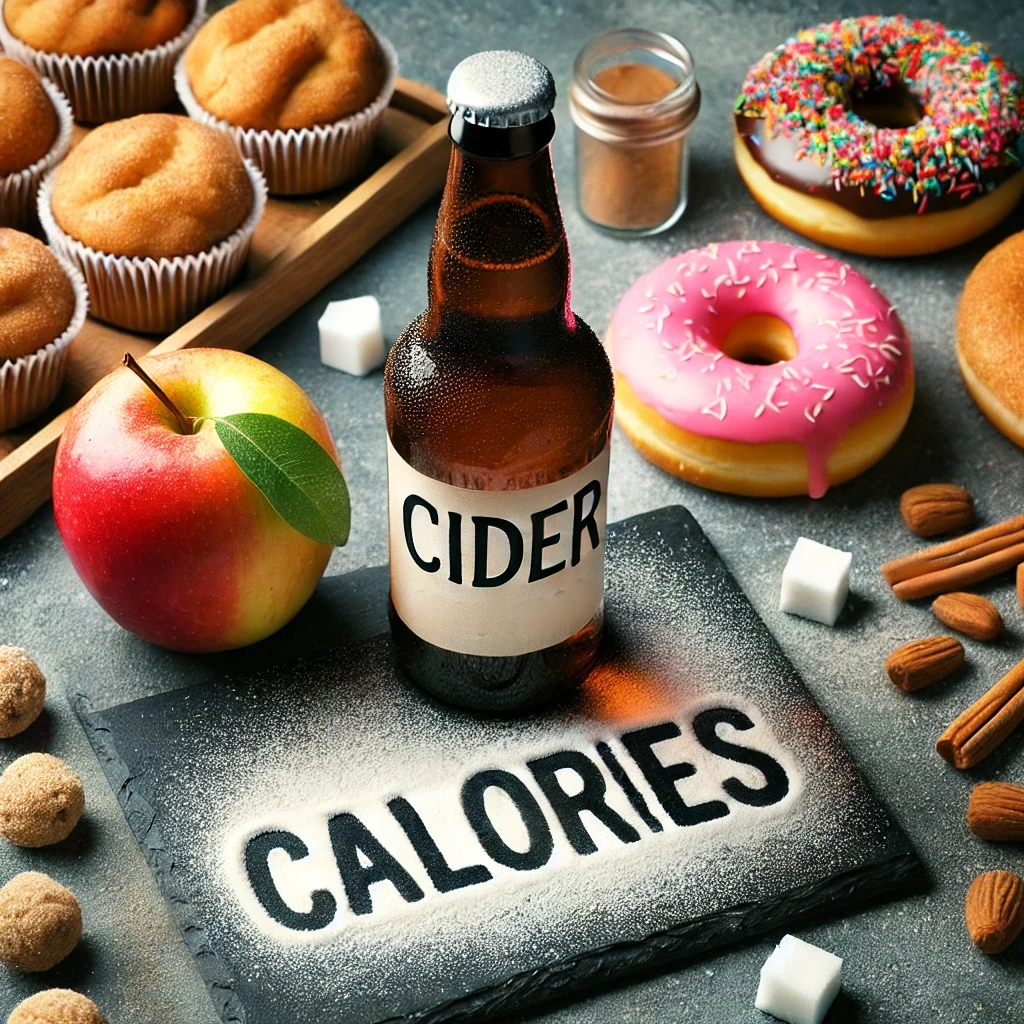The Science Behind Cider Fermentation
During fermentation, yeast cells consume sugars in the apple juice and produce ethanol (alcohol) and carbon dioxide. The process also generates various by-products that contribute to the flavour, aroma, and mouthfeel of the cider. Key factors like temperature, yeast strain, and nutrient availability significantly influence the fermentation process and the final product. This is something we cover on our cider making course in great detail as it is the most critical stage when making cider.
Essential Equipment and Ingredients
Necessary Equipment for Cider Fermentation
To start fermenting cider, you’ll need the following equipment:
Fermentation Vessel
- Glass Carboys: These are large glass containers that are excellent for cider fermentation because they are non-reactive, do not retain odours or flavours from previous batches, and are easy to clean. They come in various sizes, typically ranging from 1 gallon to 6.5 gallons, making them suitable for both small and large batches.
- Food-Grade Plastic Buckets: These are more affordable and lighter than glass carboys, making them easier to handle. They are also available in various sizes and often come with airtight lids and spigots for easy transfer of liquids. Ensure the plastic is food-grade to prevent chemical leaching.
Airlock and Bung
- Airlocks: These devices allow carbon dioxide to escape from the fermentation vessel while preventing contaminants from entering. There are two main types: S-shaped airlocks and three-piece airlocks. Both types are effective, but three-piece airlocks are easier to clean.
- Bungs: These rubber or silicone stoppers fit into the opening of your fermentation vessel and hold the airlock in place. Make sure to choose a bung that fits your vessel securely to maintain an airtight seal.
Hydrometer
- A hydrometer is an essential tool for measuring the specific gravity of your cider, which indicates the sugar content. This allows you to track the fermentation progress and determine when fermentation is complete. Hydrometers are simple to use: just float them in a sample of your cider and read the scale to get your measurement.
Sanitizer
- Keeping your equipment sanitized is crucial to prevent unwanted bacteria and wild yeast from contaminating your cider. Common sanitizers include Star San and iodophor. These are no-rinse sanitizers that are safe for food contact and effective at killing microbes. Always sanitize all equipment that will come into contact with your cider, including fermentation vessels, airlocks, and siphoning tubes.
Choosing the Right Apples for Cider
The type of apples you use will affect the flavour and quality of your cider. A blend of sweet, tart, and bitter apples typically produces the best results. Here’s a detailed look at apple varieties:
- Sweet Apples: These apples, such as Gala and Fuji, add sweetness to your cider. They are high in sugar, which will ferment into alcohol, and contribute to the overall balance of flavours.
- Tart Apples: Varieties like Granny Smith and Jonathan provide acidity, which balances the sweetness and adds a refreshing crispness to the cider.
- Bitter Apples: Apples like Dabinett and Kingston Black are rich in tannins, which add astringency and complexity to the cider. They are often used in small quantities to enhance the mouthfeel and depth of flavour.
Selecting the Best Yeast for Fermentation
Yeast selection is crucial for cider fermentation, as it influences the flavour, aroma, and clarity of the final product. Here are some common yeast types used:
- Champagne Yeast: Known for producing a dry cider with a clean finish, this yeast ferments quickly and completely, leaving little residual sugar. It is ideal for those who prefer a crisp, dry cider.
- Ale Yeast: This yeast adds complexity and fruity notes to the cider. It ferments at warmer temperatures and can leave a bit of residual sweetness, making it suitable for medium-sweet ciders.
- Wild Yeast: For natural and spontaneous fermentation, wild yeast can be used. This method is often employed by experienced brewers seeking something more unique. However, it is less predictable and can sometimes result in off-flavours if not carefully managed. This is the method used at Butford Organics to make sure everything is as natural as possible.

Step-by-Step Guide to Cider Fermentation
Preparing Your Apples and Juice
Start by washing and sanitizing your apples. Then, crush and press the apples to extract the juice. Ensure the juice is free from contaminants by using clean equipment.
Primary Fermentation Process
Add the selected yeast to your apple juice. You can also add yeast nutrients to support a healthy fermentation. Stir the mixture thoroughly to distribute the yeast evenly.
Place an airlock on your fermentation vessel and store it in a cool, dark place. The ideal temperature for cider fermentation is between 60-70°F (15-21°C). Use a hydrometer to check the sugar levels and monitor the fermentation progress.
Secondary Fermentation
Once the primary fermentation slows down (typically after a few weeks), transfer the cider to a secondary vessel to clarify and mature. This process helps to develop more complex flavours and reduce sediment.
During secondary fermentation, maintain a stable temperature and protect the cider from exposure to oxygen. This stage can last several months, depending on your desired flavour profile.
Troubleshooting Common Fermentation Issues
Identifying and Solving Fermentation Stalls
If fermentation stops prematurely, it might be due to temperature fluctuations or nutrient deficiencies. Adjust the temperature or add more nutrients to restart the process.
Addressing Off-Flavours and Spoilage
Off-flavours can result from bacterial contamination or stressed yeast. Ensure all equipment is sanitized and consider using a yeast strain known for producing clean flavours.
Managing Fermentation Temperature
Keeping the fermentation temperature within the recommended range is crucial. Use a thermometer to monitor the temperature and adjust as necessary.
Enhancing Your Cider
Tips for Improving Fermentation Results
- Aerate the Juice: Before adding yeast, aerate the juice to provide oxygen for initial yeast growth.
- Control pH Levels: Aim for a pH between 3.2 and 3.8 for optimal yeast performance.
- Use Fresh Ingredients: Fresh apples and high-quality yeast contribute to better flavours.
Experimenting with Flavours and Additives
Adding fruits, spices, or herbs can create unique ciders. Some popular additives include:
- Fruits: Cherries, raspberries, and cranberries.
- Spices: Cinnamon, cloves, and ginger.
- Herbs: Mint, basil, and rosemary.
Aging and Conditioning Your Cider
Allowing your cider to age and condition improves its flavour and clarity. Store the cider in a cool, dark place for several months before bottling.
Bottling and Storing Your Finished Cider
How to Know When Fermentation is Complete
Fermentation is complete when the specific gravity remains constant for several days. Use a hydrometer to check the final gravity, which should be around 1.000.
Safe and Effective Bottling Techniques
Sanitize all bottling equipment and bottles. Carefully siphon the cider into bottles, leaving some headspace. Cap the bottles securely to prevent contamination.
Storing Your Cider for Best Results
Store bottled cider in a cool, dark place. The cider will continue to mature and develop flavours over time. Ideally, consume within a year for the best taste.
Advanced Techniques and Tips
Natural vs. Controlled Fermentation
Natural fermentation relies on wild yeast present on the apples and in the environment. It can produce complex and unique flavours but is less predictable than controlled fermentation with commercial yeast.
Using Wild Yeast and Spontaneous Fermentation
Wild yeast can add interesting flavours to your cider. If you choose this method, be prepared for variability in fermentation times and outcomes.
Scaling Up for Commercial Production
If you’re considering commercial cider production, focus on consistent quality and scalability. Invest in larger equipment and adhere to regulatory standards for production and labelling.
Want to learn more?
If this is at all interesting to you and you want a more detailed breakdown and a closer look at the exact steps that go into this check out our cider course where we collect, mill, press, and show off our fermentation room.





